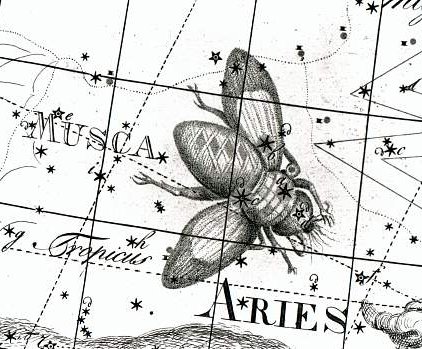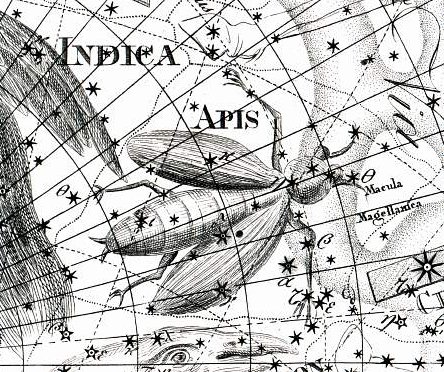2. Above Aries there once was a Fly (Musca Borealis). This is Bode's version:  Half a year later there is another Fly, this one below Crux: The Fly in the north is above its destination and the Fly in the south below its destination, in both cases seemingly to move away from the pole. I guess this could be significant, viz. that the living spirits (manu rere) depicted as flying insects return from a place high up. ... Far away, the Mangaians of old (Austral Islands, Polynesia), who kept the precessional clock running instead of switching over to 'signs', claim that only at the evening of the solstitial days can spirits enter heaven, the inhabitants of the northern parts of the island at one solstice, the dwellers in the south at the other ... Close to the celestial poles the lines of right ascension converge and the area between them becomes smaller and smaller. An idea of small constellations ('creatures') close to the poles could be the result. And what is little tend to be close to its origin ('origo').  In the picture of Bode (source Ian Ridpath's site) the 'Southern Fly' is a Bee (Apis): "A small constellation to the south of Crux, the Southern Cross. Musca was one of the 12 southern constellations introduced at the end of the 16th century by Pieter Dirkszoon Keyser and Frederick de Houtman from the stars they observed during the first Dutch expeditions to the East Indies. It was first depicted by their fellow Dutchman Petrus Plancius on his globe of 1598, but for some reason he left it unnamed. In de Houtman’s catalogue of 1603, completed after Keyser’s death, it is called De Vlieghe, Dutch for fly. Johann Bayer, also in 1603, showed the insect on his plate of the 12 new southern constellations in Uranometria but called it Apis, the Bee, an alternative title that was widely used for two centuries. The Dutch historian Elly Dekker believes that this alternative identification arose because Bayer copied his southern constellations from globes produced by Jodocus Hondius in 1600 and 1601, on which the figure was left unnamed. Not knowing what it was meant to depict, Bayer wrongly identified it as a bee (apis), not a fly (musca). The first known use of the Latin name Musca for this constellation was in 1602 on a globe by Willem Janszoon Blaeu, another Dutch cartographer and rival to Plancius. Plancius himself did not adopt a name for the constellation until 1612, when he called it Muia, the Greek for fly, on a globe produced that year ..." I have suggested the Beehive (Praesaepe) in Cancer is the 'place of birth' of Sun:
|


